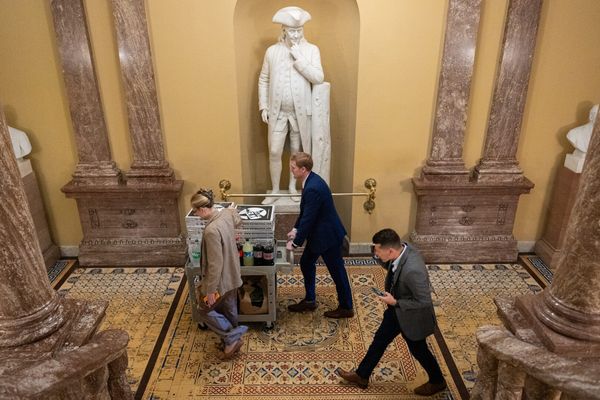
Late Japanese Prime Minister Shinzo Abe’s economic legacy is defined by a namesake strategy.
Under “Abenomics”, Abe, who was shot dead during an election campaign event on Friday, sought to jolt Japan’s economy back to life after more than two decades of stagnation following the collapse of an asset bubble in the early 1990s.
Abe’s strategy had three “arrows” aimed at kick starting economic growth and higher wages: loose monetary policy, fiscal stimulus and structural economic reforms.
Under the first two “arrows,” Abe, who was prime minister from 2006-07 and 2012-20, presided over ultra-low interest rates and quantitative easing alongside tens of billions of dollars in spending on new infrastructure and cash handouts.
The reform plank of Abenomics aimed to boost productivity by cutting red tape and corporate taxes, as well as expanding the country’s rapidly ageing workforce by encouraging the participation of more women, seniors and immigrants.
“We should look to the future, rather than worry about the present,” Abe said in a 2016 speech outlining his economic vision.
“Japan may be ageing. Japan may be losing its population. But, these are incentives for us.”
Mixed success
By most accounts, Abe, who resigned for the second time in 2020 citing ill health, had only partial success in turning around the world’s third-largest economy.
During his tenure, economic growth picked up from the doldrums of the 1990s and 2000s, exports rose, and unemployment dropped to its lowest level in decades.
Between 2015 and 2017, Japan recorded eight consecutive quarters of positive growth – the longest streak in nearly 30 years.
But compared with the heady decades of expansion following World War II and the performance of many of its peers, Japan’s economy failed to impress.
Over the course of Abe’s nearly eight-year second stint as prime minister (excluding 2020, when COVID-19 derailed the economy), real GDP growth averaged just 0.9 percent, according to an analysis by economist Kaya Keiichi.
Abe’s ambitious target of boosting nominal GDP to 600 trillion yen by 2020 never materialised and remains unmet to this day.
Moreover, inflation and wage growth fell short of expectations, putting a damper on the economic gains that were achieved.
“Although government policies can create an environment for reform and innovation by market participants to some extent, in order to actually increase labour productivity and increase investment in innovative technologies by businesses, more efforts for self-reliance among households and businesses are also essential,” Min Joo Kang, senior economist for South Korea and Japan at ING, told Al Jazeera.
“In this respect, the improvement of the real economy was limited. However, I think it was half a success in that it protected the Japanese economy from a sharp downturn.”
While Abe’s immediate successor and ally Yoshihide Suga pledged to continue Abenomics, current Prime Minister Fumio Kishida has sought to distance himself from the strategy, touting instead a “new capitalism” more attuned to the gap between rich and poor.
Last month, Abe branded an economic policy paper drafted by politicians in his Liberal Democratic Party as “idiotic”, after the former leader deemed the proposals to be critical of his signature economic policy, the Asahi Shimbun reported.
Jeffrey Halley, senior market analyst for the Asia Pacific at OANDA, said Abenomics had produced “mixed results”.
“The lack of will to implement the third arrow of economic and trade reform, as Japan fell back into entrenched ways, meant the other arrows only really managed to keep the lights on through the 2010s,” Halley told Al Jazeera.
“Inflation is still non-existent, government debt is much higher, and Japan’s trade barriers and corporate governance remain as intractable as ever. The lack of progress was not down to Abe being wrong strategically, rather it was his failure to overcome entrenched domestic interests and governmental inertia to fully embrace and execute all the arrows.”







